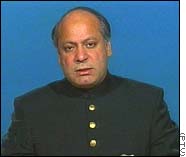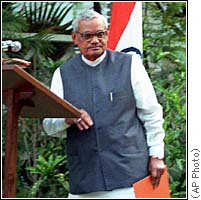| Home |
| Research |
| Downloads |
| Publications |
| Teaching |
| People |
| Press |
| Allen CV |
| Seismo Lab |
| Earth & Planetary |
| UC Berkeley |
|
Nuclear tests and verification
Jump to: |
|
NUCLEAR VERIFICATION ARTICLE:
False accusations, undetected test, and implications for the CTB Treaty. Gregory van der Vink, Jeffrey Park, Richard Allen, Terry Wallace and Christel Hennet Arms Control Today, May 1998 |
|
Pakistan Nuclear Tests - May 28-30, 1998. On May 26 the CIA reported that Pakistan had completed its preparations for a nuclear test following India's five tests conducted May 11-13 (two weeks previously). The Foreign Ministry in Islamabad insisted tests were not imminent. Despite intensive diplomatic efforts to prevent Pakistan from conducting tests since the Indian tests, Pakistan conducted is first nuclear tests on May 28.  In a televised announcement the Pakistani Prime Minister Nawaz Sharif (left photo courtesy of CNN) announced
that Pakistan had "settled the score" with India by conducting five nuclear tests. The Prime Minister did not give any technical details. Unofficial reports suggested all five devices were fission devices (atom bombs).
Three were sub-kiloton, the remaining two had yields of 25 kton and 12 kton. The sequence was similar to that conducted by India. The seismic data does not support the yields claimed by Pakistan (another similarity with the Indian tests).
In a televised announcement the Pakistani Prime Minister Nawaz Sharif (left photo courtesy of CNN) announced
that Pakistan had "settled the score" with India by conducting five nuclear tests. The Prime Minister did not give any technical details. Unofficial reports suggested all five devices were fission devices (atom bombs).
Three were sub-kiloton, the remaining two had yields of 25 kton and 12 kton. The sequence was similar to that conducted by India. The seismic data does not support the yields claimed by Pakistan (another similarity with the Indian tests).
On May 30 Pakistan conducted an additional test. There are differing reports as to its yield. Follow this link to find out more about the tests and view the data. |
|
Indian Nuclear Tests - May 11-13, 1998.  On May 11, 1998 the Indian Prime Minister Atal Behari Vajpayee (right photo courtesy of CNN) shocked the world by announcing three nuclear tests, the first Indian tests since the 'peaceful test' of 1974. The tests hailed India's entrance into the nuclear club.
While world leaders condemned the action in this era of nuclear restraint, the Indian population celebrated their national pride.
In the U.S. there was shock that the tests were not detected in advance as during the December 1995 test preparations, which were then halted due to diplomatic pressure.
As the U.S. and Japan considered whether to impose sanctions two further tests were conducted on May 13.
On May 11, 1998 the Indian Prime Minister Atal Behari Vajpayee (right photo courtesy of CNN) shocked the world by announcing three nuclear tests, the first Indian tests since the 'peaceful test' of 1974. The tests hailed India's entrance into the nuclear club.
While world leaders condemned the action in this era of nuclear restraint, the Indian population celebrated their national pride.
In the U.S. there was shock that the tests were not detected in advance as during the December 1995 test preparations, which were then halted due to diplomatic pressure.
As the U.S. and Japan considered whether to impose sanctions two further tests were conducted on May 13.
What did the tests mean for the Comprehensive Test Ban Treaty (CTBT) which was being considered for ratification at the time by the ~150 countries who had signed? Was there an intelligence failure? What does this mean for verification of the CTBT? Follow this link for an overview of the news reports, to see the seismic data from the tests, and for a list of links specific to this event. |
|
Alleged Russian test on Novaya Zemlya - August 1997. On August 28, 1997, a leak to the Washington Times alleged that Russia had conducted a nuclear test on August 16. The alleged test occurred at the Russian nuclear test site on the island of Novaya Zemlya in the Arctic Ocean. Such a test would be in violation of international law and signal the end to the Russian moratorium on nuclear tests. While U.S. officials continued to claim the Russians had conducted a test for several months, it only took a period of days for seismologists at the Prototype International Data Center (pIDC) and in the UK to independently locate the seismic event 100 km offshore, away from the test site. The false U.S. allegations were based on satellite observations of activity at the test site and the miss-location of the seismic event. This error occurred due to the use of only a limited seismic data set by U.S. authorities. In the paper The Perfect Earthquake - Again? by Richard Allen, the events of August 16 are first analyzed to demonstrate that the seismic event was a small earthquake offshore. The U.S. analysis is then reconstructed and recommendations made to prevent future miss-analysis. Finally the implications of the event for verification of the Comprehensive Test Ban Treaty are considered. Click here to see the Executive Summary. This work is currently in press. |
